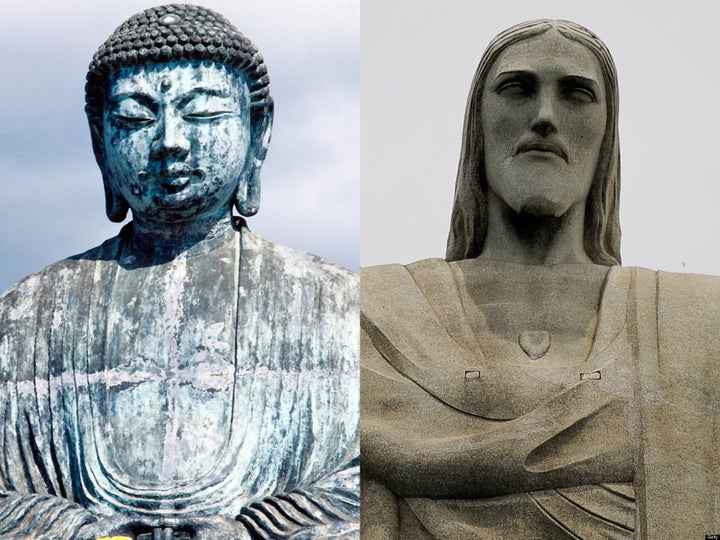
The state of American religious public discourse is profoundly impoverished. Conversations in print and broadcast media are stifling because they are largely monoreligious: Christianity appears to be the only game in town. Islam is permitted occasional appearances but only under the guise of militancy.
This week's PBS broadcast of David Grubin's documentary The Buddha is a happy exception to this stale routine. The appearance of this film reminds us of what is so sorely lacking in the public square: knowledge of other traditions which can, in turn, foster interreligious dialogue.
Pundits and preachers do talk about religion in public space, but that back and forth is routinely confined to the tired squabble between Christian fundamentalists and atheists. In religion as in politics, the most virulent partisans frame the debate and consume all the oxygen. We are left to choose between the likes of Richard Dawkins and Pat Robertson, and neither knows much about religion.
The nationwide release this week of The Buddha enriches our collective conversation. Religious communities, particularly churches, should use this opportunity to turn away from futile engagements with condescending atheists and embrace the much more demanding work of Buddhist-Christian dialogue.
David Grubin's documentary is an aesthetic treasure. Grubin makes an interesting narrative decision: he lets two poets, W. S. Merwin and Jane Hirshfield, do much of the talking, far more than the Dalai Lama or Buddhologists, although they are present as well. Siddhartha Gautama's quest for enlightenment is infused with poetic yearning; his venture comes across as one man's unrelenting effort to solve the ordinary but sacred riddle of living well in the midst of impermanence and death.
Buddhism is depicted with accuracy as the labor of learning to see clearly and wake up to life just as it is: a painful but nonetheless exquisite transitory flux. Rather than securing ourselves against life's evanescence by swimming in a sea of addictive poisons like greed, hatred, and delusion, the Buddha eliminates habitual egoism by cutting out the root ignorance that binds human beings to samsara: the illusion of self. Released from that falsehood, human beings are free to embrace life in all its fragile interconnectedness with care and compassion.
Suppose viewers become readers and follow up their viewing with a deeper encounter with Buddhist wisdom. What questions come next? Christian viewers of the film will surely be impelled to ask, what does Bodhgaya have to do with Jerusalem? What have the Buddha's teachings to do with the teachings of the Jewish carpenter from Nazareth?
The Roman Empire executed Jesus because he came proclaiming the Kingdom of God, which was an absolute inversion of the Kingdom of Caesar. Jesus announced the coming of God whose arrival gives rise to a new world order in which the poor, the oppressed, the wounded, and the outcast are accorded pride of place. His disciples came to believe that Jesus was the embodiment of the kingdom that he proclaimed. In and through him, they felt the healing power of a subversive political holiness grounded in God's love for the marginalized and the broken.
What is the meaning of the Buddha for the Christ and of the Christ for the Buddha? Can we wed together the Buddha's transcendent peace together with Jesus' shalom? The halls of academia and religious communities do not lack for learned scholars who have some mastery of one of these traditions. But we are terribly short of thinkers and practitioners, clergy and lay, who can think these two traditions together. That quest is not only an intriguing intellectual challenge but also a vital cultural project because American life is increasingly marked by intermarriage and religious hybridity. The ranks of the religiously hyphenated grow daily, but few communities are equipped for this new reality.
The time has come for religious communities to demand a new kind of clerical leadership. Every religious leader -- Rabbi, Imam, or Priest -- must be required to know a second religious language. Seminaries must develop new curricula adequate to the changing American religious landscape. These institutions must inculcate in students a measure of religious multilingualism.
And all of us, lay and clergy, must demand a new civic culture marked by interreligious hospitality and by a deep desire to learn not just about but from the faith of our neighbors. We must rise to one of the great spiritual challenges of our time: the hard work of integrating multiple religious wisdoms into our personal lives and public vocations.
John Thatamanil is Assistant Professor of Theology at Vanderbilt Divinity School in Nashville, TN. He is the author of The Immanent Divine: God, Creation and the Human Predicament. An East-West Conversation.